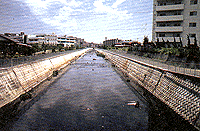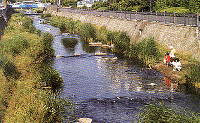
< World's WATERFRONT:JAPAN Category: Kanto >
For Ayase River, which was recorded as the worst river in terms of water quality for 15 consecutive years, a project was conducted to channel the water of Ara River upstream as part of "Limpid Stream Renaissance II" (a water environment improvement emergency action plan). This project won the Japan Society of Civil Engineers' Environmental Award in 2001 as Japan's first project using the tunnel upper part for subways and the lower part for a river water conduit.
By JRRN-secre | Category: Water quality Restoration,Kanto | Comment(0) | Trackback(0) |
Date: 2011.09.10 18:18
Furo River, running through Saitama Prefecture, was once called "Toshitorazu (meaning unaging) River" because the main water source was a spring that dried up in winter and the flowing water did not see the old year out.. However, a large quantity of living drainage was discharged into the river due to the population increase in the basin and the river was named the most contaminated river in Japan and such a disgraceful situation was continued in the past..
Now, the"basin sewage project for Furo River water quality environment conservation measures" are being conducted to recover the water environment by resolving the sewage-treated water into Furo River. Moreover, efforts are being made to conserve and regenerate the water environment through water environment improvement projects such as "Limpid Stream Renaissance 21" and "Limpid Stream Renaissance II".
By JRRN-secre | Category: Water quality Restoration,Kanto | Comment(0) | Trackback(0) |
Date: 2011.09.10 18:16
Concerning Yanase River, a tributary stream of Shingashi River, running through Saitama Prefecture, the water quality was extremely deteriorated in the decade starting in 1975 because of the rapid increase of the population during the high-growth period. However, the water quality has been improved gradually as a result of the construction of a sewage system. In 2006, a river environment improvement project was started based on the “Yanase River basin water circulation master plan”. To solve water problems related to river conservation, water utilization and the water environment, river restoration activities are being conducted under cross-sectional cooperation of not only the river administrator but also the administrative agencies concerned.
By JRRN-secre | Category: Water quality Restoration,Kanto | Comment(0) | Trackback(0) |
Date: 2011.09.10 18:15
Downstream of Ara River, wetland existed in the decade starting in 1955, but it has mostly been lost as a result of promotion of flood channel construction and low water bank protection improvement.
Therefore, efforts are being made to not only conserve the existing natural areas but also create new natural areas and establish a natural area network for the purpose of conservation of the reedy fields, conservation and regeneration of the muddy flats and regeneration of the wetland on the flood channel.
Today, a muddy flat regeneration test is being conducted in Komatsugawa district and a natural restoration plan based on new knowledge including bank protection improvement and a wave-absorbing facility installation is being researched.
By JRRN-secre | Category: Nature oriented restoration,Kanto | Comment(0) | Trackback(0) |
Date: 2011.09.10 18:02
The Arakawataroemon district lying astride Okegawa City, Ageo City and Kawajima Town is one of the districts having the former Ara River channel, where a rich natural environment merged with the ambient surroundings of the wetland and lakeside forests was formed. Today, however, the decrease in the flood frequency due to the lowering of the riverbed of the main stream of Ara River and the drying of the river by sediment deposition in the former channel are advancing and the existence of this good ecological environment is threatened.
For this reason, a natural restoration conference for the former Ara River channel was established as the first project according to the Law for the Promotion of Nature Restoration in Japan in 2003 and nature restoration programs have been conducted as an important base of Ara River ecological network.
By JRRN-secre | Category: Nature oriented restoration,Kanto | Comment(0) | Trackback(0) |
Date: 2011.09.10 18:00
The lakeside area behind Kasumigaura Bay used to have a diverse natural environment including wetlands and vegetation zones. Today, however, the natural environment around the lakeside and the biodiversity of the inhabitants have been greatly damaged.
In particular, because the population of nymphoides peltata, an endangered plant species, has rapidly diminished, urgent maintenance measures for the Kasumigaura lakeside vegetation zone have been taken to conserve and regenerate the vegetation zone in cooperation with NGO organizations closely connected with the local communities since 1996.
Also, a natural restoration project is being conducted in the Tamura, Okijuku and Tozaki districts located on the middle lakeside of Kasumigaura (Nishiura) to conserve and regenerate the lakeside zone that forms a connection point between the back hill and the lake, where a huge variety of animals and plants can grow and live.
By JRRN-secre | Category: Bay and lake restoration,Kanto | Comment(0) | Trackback(0) |
Date: 2011.09.10 17:57
Tsurumi River basin was quite activated from the late 1960s with rapid city development, but it also came to have various problems such as flood control, environment, and disaster prevention. Given the situation that flood control safety level was hard to maintain, a committee of academic experts, basin local government, and river administrator was set to find a basin-wide solution for integration of river development and flood control measures. This is a pioneer of total flood control efforts in Japan. Beyond the basin measures such as rain runoff control, the local government’s urbanization plan and development projects were involved.
>>More details (PDF 54KB)
By JRRN-secre | Category: Community and urban river restoration,Kanto | Comment(0) | Trackback(0) |
Date: 2011.03.31 18:15
Before
(source: RFC)
|
|
After
(source: RFC)
|
In 1982, Yokohama City began developing shallow water channels along the Itachi River in order to restore the waterfront to its natural state. Prior to this, mudflats had developed as a result of earlier river improvement construction projects.
There were several goals to this river Restoration plan: to maintain sufficient water depth (i.e. to restore the water depth to pre-construction levels),to restore waterfront vegetation, to revive the riverbed microtopography in both rapid and slow streams, and to develop the river-walk. Through experimentation with various construction methods, the waterfront environment has now regained its natural vitality and once again attracts the local people.
>>More details (PDF 48KB)
By JRRN-secre | Category: Community and urban river restoration,Kanto | Comment(0) | Trackback(0) |
Date: 2011.03.31 18:10
In the peripheral area of No River flowing through Tokyo, a diversified environment consisting of springs, forests, wetlands and vegetation zones spread in the past. Today, however, the diversified natural environment has been damaged by the urbanization along the river and change of land use.
Nevertheless, a project is being conducted to regenerate the wetlands by using springs, create habitats or growing spaces for various organisms and provide a place for environmental education where people can commune with nature around No River Balancing Reservoir, which was constructed to prevent flooding.
By JRRN-secre | Category: Nature oriented restoration,Community and urban river restoration,Kanto | Comment(0) | Trackback(0) |
Date: 2010.09.10 18:03
Concerning Sanban Shallows spreading off the coast of Funabashi and Ichikawa Cities of Chiba Prefecture in the inner part of Tokyo Bay, problems such as a decrease of the brackish environment, a decrease of the marine area and an increase of the shallow sea area by lowering of the ground elevation occurred because the connection between Sanban Shallows and the rivers flowing in was weakened as a result of the postwar large-scaled land reclamation and the urbanization of the backland.
For this reason, Sanban Shallows restoration plan meeting (round-table conference) was established and many residents participated in it to regenerate the nature of Sanban Shallows. Efforts are being made to restore the tidal flats that once existed, secure the biotic diversity, provide rich and stable fishing grounds with an advanced water purification function to nurture tapes philippinarum, flounder, sea weeds, etc. and create a stopping point for aquatic birds and waterfront spaces where people can commune with nature.
By JRRN-secre | Category: Bay and lake restoration,Kanto | Comment(0) | Trackback(0) |
Date: 2010.09.10 18:01
<< Previous || Next >>







